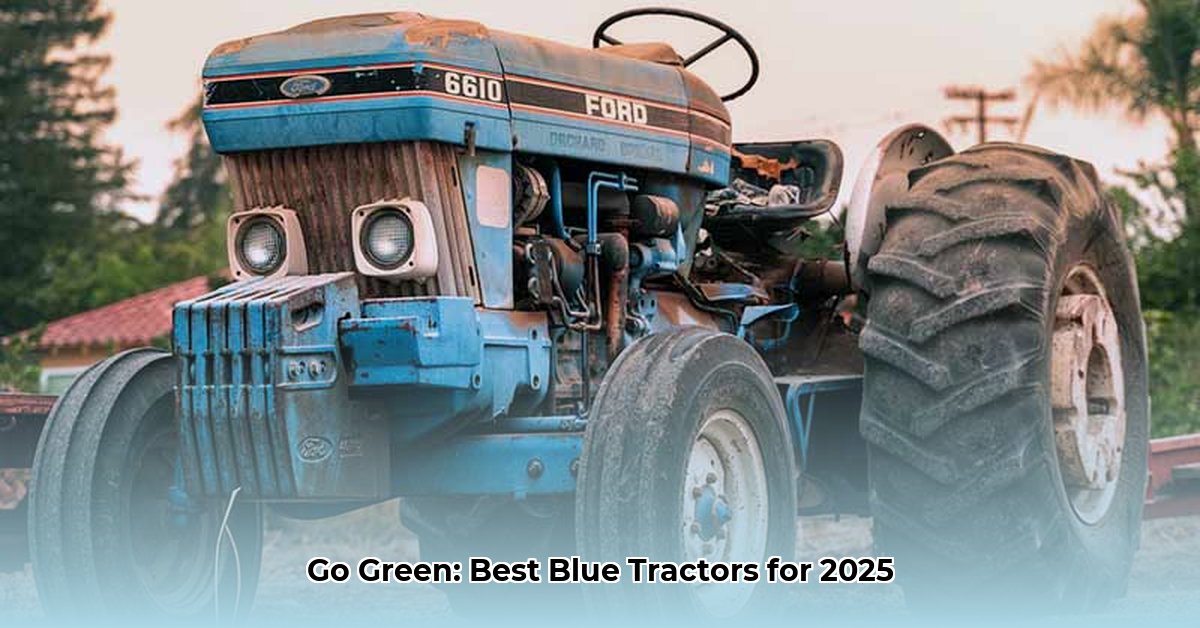
Blue Tractor Brands for Sustainable Agriculture: A Comprehensive Buyer's Guide
Choosing the right tractor is a pivotal decision for any farmer, significantly impacting both operational efficiency and environmental sustainability. The increasing focus on eco-friendly farming practices has led to a surge in demand for fuel-efficient and technologically advanced tractors, particularly those boasting the classic blue paint job. This buyer's guide helps you navigate the market, comparing leading blue tractor brands to aid in your selection process for 2025 and beyond. Are you ready to find the perfect sustainable farming partner? For more information on various tractor brands, check out this helpful resource: Tractor Brands.
The Leading Contenders: Brand Profiles and Sustainability Commitments
Several blue tractor brands dominate the market, each with its strengths and weaknesses concerning sustainable agriculture. Let's delve into some key players:
Ford
Ford, a legacy name in agriculture, enjoys a reputation for reliability and robust performance. Their commitment to sustainability is growing, with newer models featuring enhanced fuel efficiency and integrated precision agriculture technologies. Ford's extensive service network provides widespread support, though the price point for their machines tends to be at the higher end of the spectrum. Do Ford's advanced features justify the investment for your farm's needs?
New Holland
New Holland, another established competitor, offers a diverse range of tractors catering to various farm sizes and operational needs. They've made strides in incorporating sustainable features, including fuel-efficient engines and advanced precision agriculture capabilities. Their widespread service network and readily available parts contribute to their appeal. However, thorough research into specific models and features is crucial before committing to a purchase. How does New Holland's offering align with your farm's specific requirements?
Mahindra
Mahindra represents a different approach, focusing on delivering cost-effective solutions, particularly beneficial for smaller farms. Their tractors, while often employing simpler technologies compared to established giants, provide reliable performance at a more accessible price point. Their expanding service network and growing commitment to sustainability make them a compelling choice for budget-conscious farmers. How does Mahindra's balance of affordability and sustainability meet your farm's demands?
Sonalika
Sonalika, a significant player, especially in certain regions, provides tractors that often prioritize affordability and ease of maintenance. While their commitment to sustainability is evident in their newer models, they might not offer the same technological sophistication as some competitors. Their service network tends to be more regionally focused, an important factor to consider based on your location and the potential need for timely service. Is Sonalika's balance of cost and functionality right for you?
Sustainability Features Comparison: A Data-Driven Analysis
Direct comparison of sustainability metrics across brands requires careful consideration. Manufacturer specifications can vary, and real-world performance is always subject to factors such as operator skill and environmental conditions. The following table offers a comparative overview, based on available data and industry trends:
| Brand | Fuel Efficiency (Relative) | Emissions (Relative) | Precision Agriculture Capabilities | Service Network | Average Price Range |
|---|---|---|---|---|---|
| Ford | High | Medium | Advanced | Extensive | High |
| New Holland | Medium to High | Medium | Strong Integration | Widespread | Medium to High |
| Mahindra | Medium | Medium to High | Developing, Varies by Model | Growing | Low to Medium |
| Sonalika | Medium | Medium to High | Basic to Advanced, Regional Focus | Moderate | Low to Medium |
(Note: "Relative" rankings are based on general market trends and available information. Consult manufacturer specifications for precise data.)
Technological Advancements and Their Implications
Several technological advancements are defining the future of sustainable agriculture. Let's explore some key innovations and their adoption by different blue tractor brands:
Precision Agriculture: GPS-guided steering, automated application of inputs (fertilizer, pesticides), and yield monitoring significantly improve resource efficiency, reducing waste and environmental impact. All the brands mentioned are incorporating these technologies to varying degrees.
Alternative Fuels: Biofuels and electric tractors are gaining traction, promising drastically reduced emissions. However, widespread adoption faces challenges related to infrastructure development, high upfront costs, and overall technological maturity. The long-term viability of these options will depend on further advancements and supportive policy landscapes.
Engine Management Systems: Sophisticated engine control systems optimize fuel combustion, maximizing fuel efficiency and minimizing emissions. Competition is driving continuous improvement in engine technology across almost all brands.
Choosing Your Tractor: A Step-by-Step Guide
Selecting the perfect tractor involves a methodical approach. Consider these key steps:
Assess Your Needs: Determine the size of your farm, the types of crops you cultivate, and your specific operational requirements (e.g., terrain).
Define Your Budget: Tractors represent a significant investment. Establish a realistic budget, factoring in not only the purchase price but also ongoing maintenance and operational expenses.
Evaluate Service and Support: Proximity to a reliable service network is crucial, minimizing downtime during critical farming periods.
Analyze Long-Term Costs: Consider the total cost of ownership, encompassing fuel consumption, maintenance, repairs, and potential resale value.
Prioritize Sustainability: Select a tractor that prioritizes fuel efficiency and minimized environmental impact, aligning with your sustainable farming goals.
Conclusion: Driving a Sustainable Agricultural Future
Choosing a blue tractor for sustainable farming is a complex but vital decision. This buyer's guide offers you a framework for evaluating the major brands available, highlighting their strengths regarding sustainability and operational efficiency. Thorough research, careful consideration of your specific needs, and a long-term perspective are vital to making an informed choice that will support both your farm's success and a more sustainable future for agriculture.